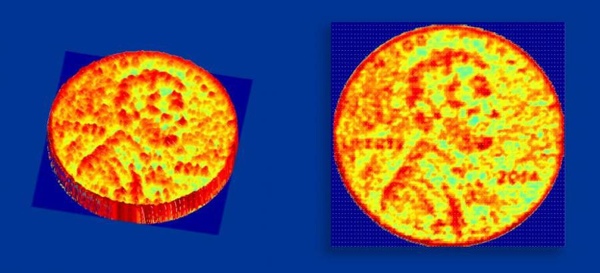A wafer of silicon microchips
Over the past few years LiDAR has become a lot smaller and more affordable than it once was, but we still have a long way to go. Solid-state LiDAR may change that, and turn this specialist technology into a tool small and cheap enough for everyone to use. DARPA, CalTech, and Quanergy have already published about their own solid-state LiDAR solutions, and there is indication Google and Velodyne might be working on their own solutions, too.
A new era of LiDAR might not be too far off. Here’s what you need to know about this technology.
What solid-state LiDAR is
Solid-state LiDAR is LiDAR on a microchip. Think of it this way: The computer microchip took all the separate transistors, resistors, and capacitors necessary for a working computer and integrated them into a single silicon chip. Solid-state LiDAR does the same thing for LiDAR, integrating its separate mechanical parts into a single microchip.

Google’s in-house LiDAR promises to be an order of magnitude cheaper than existing sensors
Why this matters
Solid-state LiDAR gains a lot of benefits from eliminating mechanical parts. For one, it is amazingly small. Researchers at CalTech have managed to develop solid-state LiDAR chips that are only about a hundred microns in size—much smaller than the diameter of a human hair.
DARPA program manager Joshua Conway, who is overseeing another project to develop solid-state solutions, says that eliminating these expensive mechanical parts also has huge cost benefits. “By finding a way to steer lasers without mechanical means,” he explained in a statement, “we’ve been able to transform what currently is the largest and most expensive part of laser-scanning systems into something that could be inexpensive, ubiquitous, robust and fabricated using the same manufacturing technology as silicon microchips.”
Unexpectedly, these benefits may come without any loss in performance. Both CalTech and DARPA emphasize that their solid-state solutions are scalable, meaning that they can be combined into arrays of nearly any size. The upshot? Systems that could someday be just as precise, if not more precise, than existing systems.

Scan of penny created using CalTech’s solid-state LiDAR chips
Commercial uses and benefits
Solid-state LiDAR is a big deal for consumers, because it will likely make the technology ubiquitous—putting it in cell phones, self-driving vehicles, and more places that couldn’t go before. However, it will also be a big deal for commercial users. For more details I spoke with Jonathan Coco, Advanced Measurements and Modeling Department Leader at Forte and Tablada.
- Speed — Beyond cost and size, he says, solid-state LiDAR has the great advantage of speed, allowing for “fast volume inventories, fast building plans, security scans, drone mapping, and so on.”
- Better SLAM — The technology will also be able to utilize SLAM (simultaneous localization and mapping) more easily than a terrestrial scanner. “Solid-state units have multiple beams and know the relative position of each beam to the others. When they fire simultaneously, you can obtain the device’s position in its surroundings from the convergence of each shot. It will provide the dead reckoning type position common to SLAM.” In other words, the device will be very good at creating a map of a space, and simultaneously using that map to figure out its own location within that space.
- Higher density — Though these sensors don’t currently deliver high density, that may change rapidly. “If they can be stacked or daisy-chained,” Coco says, “then the density should get interesting.”
- Live-Mapping — For now, with solid-state LiDAR sensors delivering low density scans, there is also a strong possibility of live-mapping. This would allow project teams to stream data back to the office in almost real time. When that’s possible, the data can rapidly processed and viewed right as the mapping is performed.
- Breaking the Point Boundary — Breaking cost boundaries is one thing, but Coco says that solid-state LiDAR scanners could one day help our industry to break the “1 million point boundary.” How? By combining them with terrestrial scanners. “It has been difficult to get beyond that boundary with one laser and one sensor, so the next logical step would seem to be multi-sensored laser scanners, like multi-core and hyper threaded computers. “Now that would be a huge leap,” he says. “One that would require massively powerful computers to work on the data.”
To put it simply, solid-state LiDAR scanners could lead to a whole new era of 3D-imaging, for consumers and commercial users alike.






